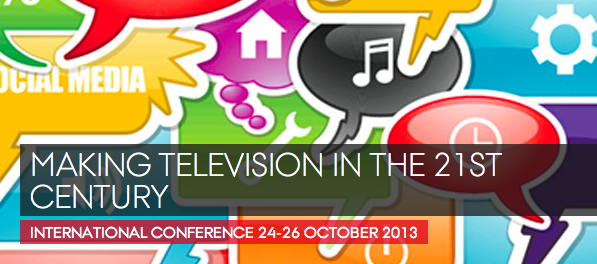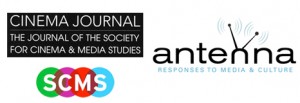Making Television in the 21st Century Conference Report
 Fresh insights and global perspectives dominated the Making Television in the 21st Century Conference held in Aarhus University, Denmark from October 24-26. The common thread uniting the wide-ranging talks was the pursuit to provide updated models and methods to make sense of the evolving medium.
Fresh insights and global perspectives dominated the Making Television in the 21st Century Conference held in Aarhus University, Denmark from October 24-26. The common thread uniting the wide-ranging talks was the pursuit to provide updated models and methods to make sense of the evolving medium.
In the inaugural keynote, John T. Caldwell (UCLA) presented an analysis of the complex media labor system, and its financial environment, based on a three-part model regime: the “Craft-World,” the “Brand-World,” and the “Spec-World.” In the “Craft-World” the aesthetic goal is to create a durable artifact, while in the “Brand-World,” flexible reformatting and concept-iteration are fundamental. The “Spec-World”, in contrast, seems to be more disaggregated. It is based on a sharing culture and tends to offer virtual pay systems.
However, these three regimes are not detached, as they form a connected “para-industrial buffer” that scholars and producers must conciliate. For example, there is a “Corporate Spec-World” that deals with brand reformatting from a speculative point of view. Moreover, Caldwell suggested that, in the actual context, all media products seem to function as a television pilot, a prototype opened to speculation and replication. Disney is a good example of this idea. As Caldwell observed, with the ABC series Once Upon a Time, the company has found a new mode to recreate its own brand. This process becomes more evident in episodes in which we can see real actors re-enacting scenes from classic Disney animated movies.
The conference also offered space for interesting ideas about Netflix and Amazon as new operators in the television industry. Sarah Arnold, from Falmouth University, posed the provocative question: “Is Netflix really television?” The diffusion method used by the streaming platform, promoting the binge viewing of its new series, makes Arnold question the televisual aspect of the streaming platform. Can we talk about television without a regular and scheduled content?
In the same panel, Jakob Isak Nielsen, from Aarhus University, added that one challenge that Netflix must face is to find a specific target group for its new content, as premium cable networks mostly do. Besides, the company must deal with the difficult situation of dealing with other television networks to offer their content on streaming and, at the same time, be one of its competitors. According to Nielsen, the future of Netflix happens to be less dependent on licensing material.
While most discussions about quality TV or the Golden Age of TV are rooted in US programming, this conference fittingly examined the recent international appeal and acclaim of Danish series such as Borgen, The Killing, and The Bridge, the latter of which is a co-production with Sweden. Heidi Philipsen of The University of Southern Denmark and Tobias Hochscherf of The University of Applied Sciences Kiel presented “Television Dogmas of Creativity? The Cross-Fertilisation of Film and Television as a Prerequisite for Danish Television’s Recent Success,” detailing a new partnership and subsequent production culture, “television dogmas for production” that was influenced by the 1990s-era Dogma film movement. The key principles include double storytelling, crossover between film and TV for a “cinematic touch,” and the significance of the writers, who hold the final say.
Within this dogma, the National Film School that is behind the development incorporates predefined themes, actors, teams and genres. Within the industry, the reputable public service broadcaster Danmarks Radio (DR) provides easy national financing for the creators, allowing room for innovation and stating that “failure is OK,” if not often necessary, for the creative process. As Philpsen and Hochscherf have interviewed these practitioners and will soon observe onsite filming, they informed that the conditions include 20 weeks of development and 20 weeks to shoot 24 episodes. In a conversation with Caldwell, the three agreed that these modes are not unique to Denmark, but quite similar to US schedules. A version of this paper will be included in the forthcoming Danish TV dossier in the Journal of Popular Television.
In the same Danish Drama TV panel, Lynge Agger Gemzøe described the national identities associated with the Swedish-Danish production of The Bridge and later compared the original with the US adaptation on FX. A French-British version called The Tunnel has also recently been released.
Afterwards, Pia Majbritt Jensen and Anne Marit Waade dissected the pros and cons of external funding for Danish programming. While outside sources can provide an abundance of money, Danish creative control can be weakened. Likewise, public service to the nation’s audience can also be replaced for international appeal to sell series abroad. In a separate panel, Hanne Bruun described the flux of Danish broadcast journalism, highlighting the tensions between the people, media and state and providing non-Danes a context to understand future plots in the politics of Borgen, a series very specific to the country’s government, with clear universal appeal, that has been broadcast in 60 countries.
In addition to Danish programming, numerous quality papers were given on British, German, Italian, Scandinavian, and Spanish and television industry and production practices.
In the last keynote panel of the conference, questions about the next challenges of television production were posed from a European perspective. Lothar Mikos, Professor of Television Studies, Academy of Film and Television “Konrad Wolf” in Potsdam, Germany, suggested a system of transnational co-productions as a real possibility to create and finance large scale television series to compete with the US. The European film industry, as Mikos reminded us, is a good example of this kind of cooperation between different countries and agents. Additionally, the emergence of Netflix offers a new alternative of partnership for European television channels following the case of Lillyhammer, a Norwegian-American production. However, every country is different and Denmark, as was proved along the entire conference, has found its own receipt for success adapting the American television system based on the crucial figure of the showrunner.
In conclusion, the conference celebrated risk and transgression as a main goal for television production in this 21st century. “Audience demands originality”, declared Lotte Lindegaard, head of TV2 Denmark.
 This post is part of an ongoing partnership between the University of Wisconsin-Madison’s Antenna: Responses to Media & Culture and the Society for Cinema & Media Studies’ Cinema Journal.
This post is part of an ongoing partnership between the University of Wisconsin-Madison’s Antenna: Responses to Media & Culture and the Society for Cinema & Media Studies’ Cinema Journal.


